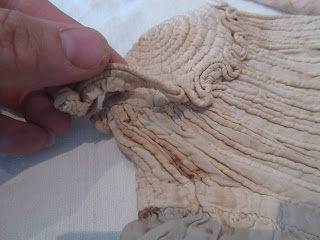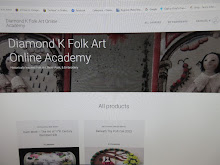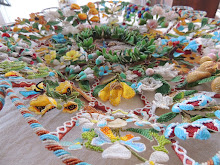Friday, July 30, 2021
How to Separate Soie Ovale
Sunday, July 25, 2021
New Little Helpers....
Hand Painted Needle Minders
In case you are not familiar with a needle minder, it has a magnet on the back and comes with a second. You place the minder on the front of the fabric, and the second magnet behind it on the back of the fabric and this holds the minder in place. The magnets are very strong and hold any pins or needles you put on the front of it in place.
If you are in need of one, they are available today in my ETSY store, link is to the right in the sidebar.
Happy Stitching!
Wednesday, July 14, 2021
A Few Thoughts on Washing...
First Quarter 19th c Child's Gown & Cap


Thursday, July 08, 2021
2021 Heirloom Casket Toye & Ornament Kit
Flemish Coffer
Monday, July 05, 2021
A Summer Weight Suit
To Celebrate Summer, 1825-40 Style!
Happy July! I hope all of my US readers had a happy & safe holiday this past weekend. I am now home from a up to see my parents in Washington. It has been over 2 years since I had seen them due to blasted covid! It was HOT. Pip cooked an egg on the sidewalk on a 105+ degree day...and yes, I have the video to prove, it really does work! I had planned to put up this year's ornament kit for sale when I got back home, but as usual, I am a little behind. I took work with me on my trip, but just couldn't wrap my brain around it so here I am, behind as always. Hopefully, I'll get it done and up later this week!In the meantime, I wanted to share a peek at this stunning little buys suit. I have a wide date on it from 1825-40 as it is so hard to date more everyday wear for boys that dont have fashionable cuts to help date them. The high armscyes, curved back seam, turnback pointed cuffs and faux waistcoat can all be found in garments in that time period window. Straps on petticoats and trousers were very common in 1820-30 periods, and some even crept their way into the 1840s.
One thing that I love about this particular suit is its condition. It was not worn once on some special occasion and put away. It was a daily use garment and it shows magnificently by the wear and repairs. The above view of the trousers is the backside of them. Note the coarse printed insertions center back...this is not an alteration. The waistband, this back section that would never be seen when worn with the jacket, and the lining of the jacket is all original construction. The plaid fabric has been pieced together from several tiny pieces~ most likey leftover scraps from Mom or Dad's clothing. The trousers are open from the crotch to the waistband in the back, as shown. The cut of the seat is full to allow ample room for the bum when sitting.Here is a tip when trying to decypher original garments and wear, from 'fakes' (garments made to deceive)...
Elbow wear is nearly never at the actual 'elbow' but below it. When wearing a long sleeve jacket we tend to jet the arms out forward before we bend them, say to rest the elbows on a table. This, along with bending of the arm, hikes the sleeve up the arm...wearing the fabric in an area down closer to the wrist.
























































